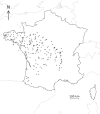Diatom Cooccurrence Shows Less Segregation than Predicted from Niche Modeling
- PMID: 27128737
- PMCID: PMC4851409
- DOI: 10.1371/journal.pone.0154581
Diatom Cooccurrence Shows Less Segregation than Predicted from Niche Modeling
Abstract
Species cooccurrence patterns give significant insights into the processes shaping communities. While biotic interactions have been widely studied using cooccurrence analyses in animals and larger plants, studies about cooccurrences among micro-organisms are still relatively rare. We examined stream diatom cooccurrences in France through a national database of samples. In order to test the relative influence of environmental, biotic and spatial constraints on species' incidence distribution, cooccurrence and nestedness patterns of real communities were compared with the patterns generated from a set of standard and environmentally constrained null models. Real communities showed a higher level of segregation than the most conservative standard null models, but a general aggregation of cooccurrences when compared to environmentally constrained null models. We did not find any evidence of limiting similarity between cooccurring species. Aggregations of species cooccurrences were associated with the high levels of nestedness. Altogether, these results suggested that biotic interactions were not structuring cooccurrences of diatom species at our study scale. Instead, the patterns were more likely to be related with colonization patterns, mass effect, and local temporal dynamics of diatom biofilms. We further highlight that the association of standard and environmentally constrained null models may give realistic insight into the cooccurrence patterns of microbial communities.
Conflict of interest statement
Figures




References
-
- Weiher E, Keddy P. Ecological assembly rules: perspectives, advances, retreats. Cambridge, GBR: Cambridge university press; 1999.
-
- Abrams P. The Theory of Limiting Similarity. Annual Review of Ecology and Systematics. 1983;14: 359–376. 10.1146/annurev.es.14.110183.002043 - DOI
-
- Watkins AJ, Wilson JB. Local texture convergence: a new approach to seeking assembly rules. Oikos. 2003;102: 525–532.
-
- Leibold MA, Holyoak M, Mouquet N, Amarasekare P, Chase JM, Hoopes MF, et al. The metacommunity concept: A framework for multi-scale community ecology. Ecology Letters. 2004;7: 601–613.
Publication types
MeSH terms
LinkOut - more resources
Full Text Sources
Other Literature Sources

